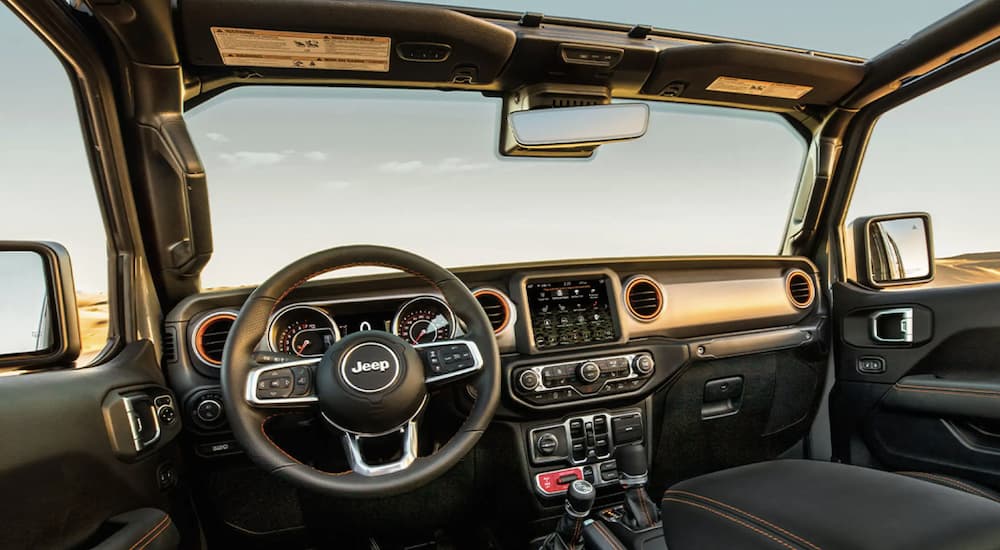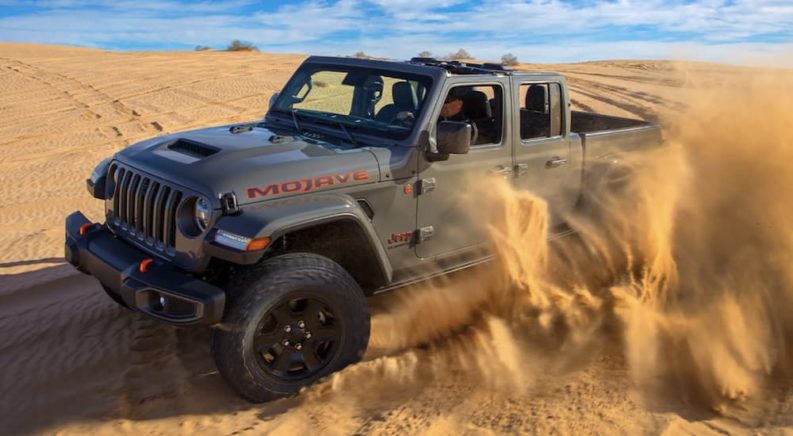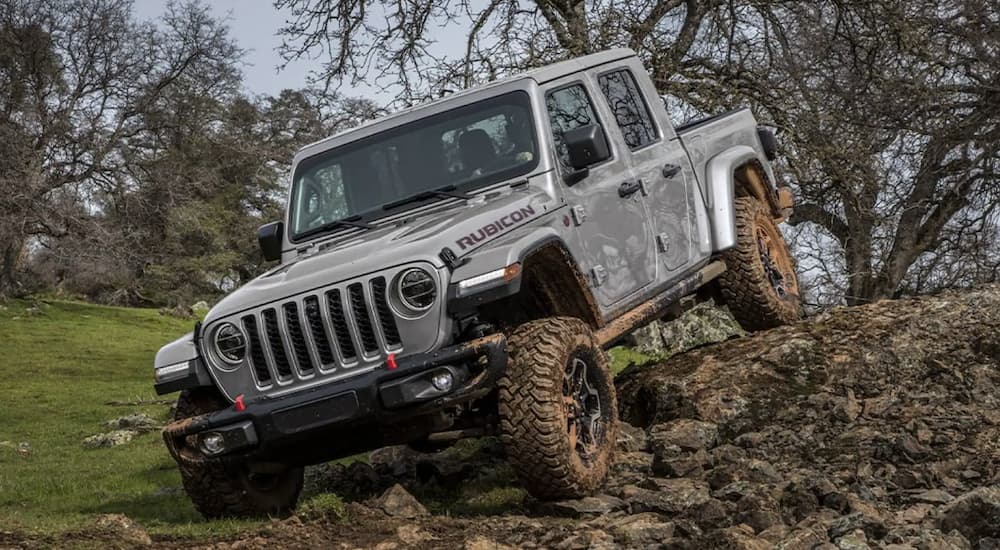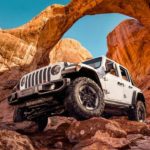Long has conflict simmered in the land of the midsize truck. The harsh, unforgiving arena of the automotive marketplace has seen many a vehicle rise to fame, bathed in glory and anointed with award after award, only to be taken down by a stronger competitor who seeks to build their own legacy on the ashes of those who came before. However, the current pickup pecking order has long been established, with seasoned warriors retaining their spot in the hierarchy due to little more than name recognition and public favor. Many ambitious upstarts have attempted to dethrone the reigning champions only to find their own oil staining the sands of the off-road surfaces where they do their battle, but that could well soon change. There’s a new combatant in the battle of the midsize pickups with a name that should strike fear into the hearts of the old guard: the 2022 Jeep Gladiator.
Meet Our Champion
Jeep’s new midsize pickup, which debuted in 2019, entered the market at a historic, high-water moment in the segment. Sales of midsize pickups skyrocketed by more than 20 percent in 2019, with the sale of smaller trucks, in general, reaching a 13-year high. In many ways, it was the perfect time for Jeep to reenter the pitched battle that is the midsize pickup segment. The brand hadn’t fielded a truck of any kind since the 1992 Comanche, but with the growth in the midsize segment, Jeep knew that it couldn’t sit on the sidelines while the legacy models fought it out. The Gladiator is based on the same platform as the popular Wrangler, giving the pickup instant Jeep cred and proving that, truck body aside, this is a Jeep product through and through. So how does the 2022 Gladiator stack up against the competition in the colosseum that is today’s midsize pickup segment? We’ll pit the Jeep against a few of the other leading models and see which ones get the all-important thumbs-up.
While they say all’s fair and love and war, even the Roman Colosseum had some ground rules, so let’s lay out a few of our own before continuing. First off, midsize pickups are nothing if not customizable. This is a rather ingenious approach on the part of auto manufacturers, allowing drivers to build their own rigs from the ground up to serve any number of distinct roles. Today’s trucks can be tailored to serve as off-road behemoths, towing and hauling specialists, performance demons, or just everyday drivers, making it difficult to conduct an apples-to-apples comparison between models. For that reason, we’re going to stick with the base model of each pickup, where the different versions can all start off on relatively even footing.
We’ll be pitting the 2022 Jeep Gladiator against the base models of two of its leading competitors in the midsize pickup category: the 2022 Chevy Colorado Work Truck and the 2022 Toyota Tacoma SR. All three trucks are respectable choices in their own right, with the Tacoma benefitting from excellent resale value and the Colorado bringing Chevy’s legacy for affordable performance to the party, but how do they compare to Jeep’s newest pickup offering? In order to determine who will be the last truck standing in the three-way match, we’ll see how they match up in five key areas: drivetrain, engines, off-roading, and hauling.

Making Off-Road Performance Standard
One factor that truly sets the Gladiator apart from Toyota and Chevy’s offerings comes down to four-wheel drive being included as a standard feature. Starting at $36,480, the Jeep might have a higher price tag than the other two pickups, but unlike those models, you don’t have to invest in an upper-tier trim package to get a vehicle that’s ready for off-roading right out of the box. While the 2WD Extended Cab Work Truck version of the Chevy Colorado is the best bargain option among the three at $25,435, the cheapest 4WD version of the Extended Cab Work Truck will set you back $29,335. Toyota’s pickup follows a similar pricing structure, with the most affordable 4WD version, the SR, coming in at $29,775––a $3,000 markup over the base model with 2WD. Given that many drivers are drawn to the pickup segment for 4WD alone, we have to give the nod to the Jeep for not nickel-and-diming the public.
Who Wants a Four-Cylinder Truck?
The engine is another area where the Gladiator runs roughshod over other base-model midsize pickups. First off, it’s the only one of the three that offers a V6 as a standard option, with the Tacoma and Colorado both opting for relatively underpowered four-cylinder options unless you pay more. This isn’t a huge surprise: with the midsize pickup’s popularity as a fleet vehicle, it’s easy to understand why automakers would want to cut back on some of the bells and whistles in order to keep the price manageable. This argument is less compelling when the trucks are being used as personal vehicles.
While an I-4 engine might be serviceable on some smaller, compact pickups, it provides a noticeable lack of power on these larger trucks. The Jeep’s 3.6-liter V6 engine is able to produce 285 horsepower and is also a leader when it comes to torque, with 260 lb-ft in total. At 200 horsepower and 191 lb-ft of torque, the 2.5-liter engine on the Colorado comes in second, but it’s the Toyota that really lags behind. The Tacoma’s base 2.7-liter engine churns out just 159 horsepower, which, when combined with 180 lb-ft of torque, puts the pickup in a distant third. Again, these latter two options might be cheaper to begin with, but there is no excuse for a pickup that can’t break 200 horsepower.
Hitting the Trails
Given the Gladiator’s Jeep heritage, it’s little surprise to see it perform well when it comes to off-roading. Jeep has practically built its whole brand around the idea of kicking up some mud with some off-road antics, and the Gladiator carries that tradition over into the pickup segment. Case-in-point: the Gladiator is the only pickup to come standard with a six-speed manual transmission, allowing drivers the precise control required for a good day on the trails.
With the Wrangler’s status as an off-road beast, we’re not too surprised by the Gladiator’s ability to do the platform proud, but Jeep has actually made a few tweaks that further up the ante, such as increasing the space between the pickup’s front and rear wheels by 19.4 inches to improve comfort and handling. Jeep’s long-awaited pickup also comes with every heavy-duty off-road component you can imagine, from skid plates and tow hooks to an elevated air intake that allows the Gladiator to navigate up to 30 inches of water.
The Colorado is no slouch when it comes to off-roading, though the base model is a bit underwhelming when not on paved surfaces. Drivers looking for a Chevy that’s ready to tackle the trails will have to pony up for the Trail Boss package available for the LT and Z71 trims or spring for the off-road-specific ZR2. These packages see the addition of a 1-inch suspension lift, skid plates, and tow hooks, but again, they are not available on the base model Work Truck. The Tacoma suffers the same fate as the Colorado––there are some great off-road options on the upper end of the trim lineup, but they’ll cost you. The TRD Off-Road trim comes with an electronic locking rear differential, and Toyota also offers a TRD Pro with impressive shock absorbers, a lifted suspension, and larger tires, but these off-road models aren’t always the most comfortable when it comes to everyday driving.
Are These Trucks Work-Ready?
Any decent pickup should be able to hold its own when it comes to towing and payload capacity, so how do these 2022 offerings stack up? Well, it all depends on what you want to use them for. The base Gladiator bests the competition by 500 pounds when it comes to towing capacity, with the ability to haul some 7,650 pounds. The Colorado and Tacoma fall slightly behind, with the base models maxing out at 3,500 pounds, but payload is a different story altogether.
The Gladiator doesn’t exactly struggle to keep up, with the Sport model posting a payload capacity of 1,700 pounds, but it isn’t the clear winner compared to the Colorado and Tacoma’s 1,716 and 1,685. It might seem odd that the Jeep can beat out the Chevy and Toyota so much in towing but barely break even in payload, but it’s the result of the trucks’ intended uses. As an adventure-ready 4×4, the Jeep is less likely to be called upon for the sort of workaday tasks that the Colorado and Tacoma often find themselves completing, making payload capacity a less crucial factor. On the upside, the Jeep’s untouchable towing capacity allows drivers to easily bring along any equipment for additional off-road fun, such as ATVs, snowmobiles, or dirt bikes.
A New Champion Takes Its Place
As the dust settles on the automotive rumble between these three worthy competitors, the winner is clear. The 2022 Jeep Gladiator not only outperforms the Toyota Tacoma and Chevy Colorado in a head-to-head comparison, but it also offers a better value without the need to add on expensive trims and package options. With Jeep’s considerable off-road reputation backing it up, the Gladiator is sure to become a force to be reckoned with in the category.
We’re not ready to give the Toyota and Chevy the fatal thumbs-down just quite yet as they both perform well when comparing higher trim levels, but between the standard six-speed manual transmission, standard 4WD, and a standard V6 engine, the 2022 Jeep Gladiator is truly the king of the off-road ring when it comes to this generation of midsize pickups. Just remember: If you find yourself alone, riding in the well-styled comfort of a class-leading midsize pickup with the sun on your face, do not be troubled. For you are in a 2022 Jeep Gladiator, and you’re already having a great time.





